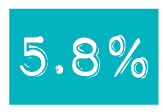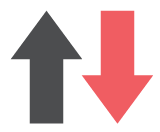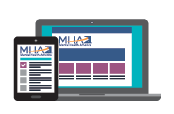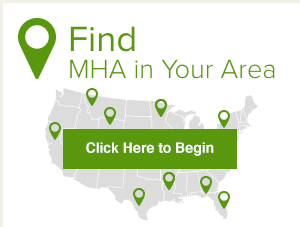You are here
Risky Business: Compulsive Buying
Everybody shops. It’s how we get necessities like food and clothing, and luxury items like cell phones and home decor. Now more than ever, it’s easier to buy things with 24-hour online shopping, but when does shopping become compulsive buying?
Americans spend a lot of money shopping
| In 2016, Americans spent over $4.8 trillion on retail purchases. [1] | That's enough to cover the entire surface of the Earth in $100 bills. |
 |
 |
For some people, shopping turns into compulsive buying
Compulsive buying is an uncontrollable desire to shop which results in spending large amounts of time and money on the activity. Generally a person who buys compulsively gets the urge to shop in response to negative emotions (not to be confused with occasional “retail therapy”) and often has problems with relationships and finances as a result of their shopping behavior. [2]
 |
of Americans are affected by Compulsive Buying Disorder in their lifetime. [3] |
The four stages of compulsive buying [4]
- Anticipation: Thoughts and urges start. They may focus on a specific item or the act of shopping itself.
- Preparation: Research and decision making take place. A person may look into sales or debate about where to go shopping.
- Shopping: Shopping happens. This is the so-called, "thrill of the hunt." The person gets a "high" while doing it.
- Spending: Something, or many things, are purchased. The personis sad that the shopping experience is over and may be disappointed about how much they've spent afterwards.
Are you at risk for a compulsive buying problem?
If you agree with most of the statements below, it may be time to seek help. [5]
- If I have money left in my paycheck, I have to spend it.
- Other people would judge me if they know how much I spend.
- I buy things that I can't afford.
- I've overdrawn my bank account buying things that I didn't need.
- Buying things makes me feel better.
- I'm anxious on days that I don't go shopping.
- I pay the bare minimum on my credit card(s), but keep charging items.
How is compulsive buying different from hoarding?
People who compulsively buy may purchase so many items that it leads to hoarding. Sixty-one percent of people with hoarding problems meet the criteria for compulsive buying [6]; however, there are also key differences between compulsive buying and hoarding. [7]
 |
 |
|
| Process of shopping |  |
The item being acquired |
| To elevate social status or relieve negative emotions |  |
To collect items that have sentimental value or perceived usefulness |
| Little to none |  |
Strong emotional connection to items |
| Purchased items are either flaunted or hidden |  |
Items are accumulated to the point where the functionality of a person's home is compromised |
| More common among women |  |
More common among men |
How is compulsive buying related to mental illness?
 |
People who have Compulsive Buying Disorder often meet the criteria for other mental illnesses as well, such as mood disorders, anxiety disorders, substance use disorders, eating disorders, ADHD, and a variety of impulse control disorders. [8] |
 |
Excessive spending can be a symptom of Borderline Personality Disorder. [9] |
 |
Spending sprees may occur during manic episodes of Bipolar Disorder; however, this is different from Compulsive Buying Disorder and spending sprees generally stop once a manic episode has ended. [10] |
 |
Compulsive buying is often driven by feelings of anxiety, depression or low self-esteem. [11] |
How is compulsive buying treated?
 |
Some professionals classify compulsive buying as an obsessive compulsive disorder, while others liken it to an impulse control disorder [12]. Therefore, there is no one specific treatment for compulsive buying. |
 |
Treatment for compulsive buying is determined by a provider after consulting with an individual. |
 |
Medication may be used to manage symptoms of underlying mental illness and control unwanted or intrusive thoughts about shopping. |
 |
Cognitive behavioral therapy (CBT) is almost always incorporated into treatment for compulsive buying. |
 |
Support groups modeled after 12-step programs have been helpful in dealing with compulsive buying behaviors. Debtors Anonymous (www.debtorsanonymous.org) is one such support group and has meetings at locations across the country. |
 |
Other ways of addressing compulsive buying include self-help books and simplicity circles. [13] |
Take control of spending
- Keep track of your spending to see if you notice patterns.
- Set a budget for how much you can spend on shopping. You may want to set weekly limits. Use cash for shopping purposes and keep your credit and debit cards at home when you go out.
- Identify what triggers the urge to shop or spend, and think about what you can do to manage those triggers.
- Do your best to avoid the urge to shop for unnecessary items before bills are due or immediately after getting paid.
- When you have money that is “burning a hole in your wallet,” transfer it to a savings account or use it to pay off credit card balances.
- If you can’t fight the urge to shop completely, channel it productively. Buy necessities like cleaning supplies or toiletries instead of clothing, electronics or other luxury items.
If you need help
 |
Take a screen at mhascreening.org to determine if you are experiencing signs of an underlying mental illness. Use the results to start a conversation with your health care provider. |
 |
Seek specialized treatment. You can find treatment providers using the online SAMHSA Treatment Locator at findtreatment.samhsa.gov or by calling the SAMHSA 24/7 Treatment Referral Line 1-800-662-HELP(4357). |
If you or a loved one is in a mental health crisis, please either visit your local Emergency Room, call 911, reach out to The National Suicide Prevention Lifeline's 24 hour toll-free crisis hotline, 1.800.273.TALK (1.800.273.8255), or text "MHA" to 741741 to receive text-based crisis help.









this page